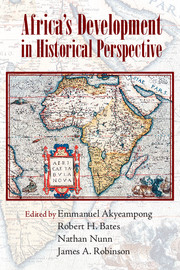Book contents
- Frontmatter
- Contents
- Author Biographies
- Acknowledgments
- Introduction
- Part I La Longue Durée
- Part II Culture, Entrepreneurship, and Development
- 5 Redistributive Pressures in Sub-Saharan Africa: Causes, Consequences, and Coping Strategies
- 6 Accumulation and Conspicuous Consumption: The Poverty of Entrepreneurship in Western Nigeria, ca. 1850–1930
- 7 Commerce, Credit, and Mobility in Late Nineteenth-Century Gold Coast: Changing Dynamics in Euro-African Trade
- 8 The Textile Industry of Eastern Africa in the Longue Durée
- 9 Explaining and Evaluating the Cash Crop Revolution in the “Peasant” Colonies of Tropical Africa, ca. 1890–ca.1930: Beyond “Vent for Surplus”
- 10 Reinventing the Wheel: The Economic Benefits of Wheeled Transportation in Early Colonial British West Africa
- 11 Mbanza Kongo/São Salvador: Culture and the Transformation of an African City, 1491 to 1670s
- Part III Institutions
- Part IV External Forces
- Index
- References
10 - Reinventing the Wheel: The Economic Benefits of Wheeled Transportation in Early Colonial British West Africa
Published online by Cambridge University Press: 05 September 2014
- Frontmatter
- Contents
- Author Biographies
- Acknowledgments
- Introduction
- Part I La Longue Durée
- Part II Culture, Entrepreneurship, and Development
- 5 Redistributive Pressures in Sub-Saharan Africa: Causes, Consequences, and Coping Strategies
- 6 Accumulation and Conspicuous Consumption: The Poverty of Entrepreneurship in Western Nigeria, ca. 1850–1930
- 7 Commerce, Credit, and Mobility in Late Nineteenth-Century Gold Coast: Changing Dynamics in Euro-African Trade
- 8 The Textile Industry of Eastern Africa in the Longue Durée
- 9 Explaining and Evaluating the Cash Crop Revolution in the “Peasant” Colonies of Tropical Africa, ca. 1890–ca.1930: Beyond “Vent for Surplus”
- 10 Reinventing the Wheel: The Economic Benefits of Wheeled Transportation in Early Colonial British West Africa
- 11 Mbanza Kongo/São Salvador: Culture and the Transformation of an African City, 1491 to 1670s
- Part III Institutions
- Part IV External Forces
- Index
- References
Summary
Introduction
Today sub-Saharan Africa is the poorest part of the planet. Though scholars and researchers debate just when the gap between Africa and the rest of the world developed, it is clear that Africa lagged behind Eurasia in terms of many of the key building blocks of economic growth. One can see this in the factors that go to determine income, for example literacy and human capital, but it is perhaps most evident in technology. The basis of the modern economic growth that emerged in Britain in the late eighteenth century was technological innovation, and the Industrial Revolution had itself built on a long incremental series of innovations in agriculture, transportation, and elsewhere in the economy. Many of these innovations did not take place in Africa. For example, outside of Ethiopia, no African country innovated the plow. Similarly, systems of writing were largely restricted to the same region, though also encompassing the Sudan and Somalia. Also absent was the wheel.
The fact that wheeled transportation was not used in sub-Saharan Africa until the early colonial period is paradoxical because it is well established that African societies knew about the wheel from the early modern period onward. They did not have to reinvent the wheel, only adopt it. Law (1980) documents many cases where Europeans gave gifts of wheeled transportation to different African kings. Wheeled carriages were in use in Dahomey from at least the eighteenth century and were even produced there. Nevertheless, wheeled vehicles did not spread out of ceremonial uses with the exception of a small amount of military use.
- Type
- Chapter
- Information
- Africa's Development in Historical Perspective , pp. 321 - 365Publisher: Cambridge University PressPrint publication year: 2014
References
- 16
- Cited by



